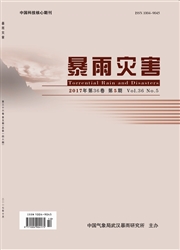

 中文摘要:
中文摘要:
利用武汉观象台2010年6—7月及2013年6月的加密探空资料,采用两种不同方法与同期同址的MP-3000A型地基微波辐射计资料进行对比分析,讨论了地基微波辐射计探测精度的变化特征。微波辐射计与探空平均廓线对比结果表明,微波辐射计对温度及水汽密度探测精度较高,降水对微波辐射计探测有一定影响。通过对比不同时次的探空与微波辐射计探测资料发现,无降水时,微波辐射计探测的温度及相对湿度在14:00的系统误差较08:00及20:00明显偏大,14:00大气层结不稳定,气球的漂移会对对比探测产生一定的影响。温度及水汽密度在08:00的均方根误差均为最小。微波辐射计与探空的分层对比结果显示,无降水时,20:00的相对湿度均方根误差在4km以上明显大于08:00和14:00,温度的系统误差在14:00最大,特别是3km以上。降水时,总体而言,14:00的探测偏差大于08:00及20:00。通过对比降水条件下微波辐射计天顶与斜天顶观测的廓线发现,斜天顶观测能够有效减小降水对观测的影响,但斜天顶观测在14:00的探测偏差总体上仍大于08:00及20:00。
 英文摘要:
英文摘要:
The variation of ground-based microwave radiometer measurement accuracy is discussed by comparing the radiosonde data and microwave radiometer data from June to July2010and June2013in Wuhan using two different methods.By comparison of average profiles,we found that the microwave radiometer(MWR)measurement accuracy of temperature and water vapor is high and precipitation influences the measurements of MWR.From the comparison between radiosonde observations(RAOBs)and MWR measurements,we can see that the systematic error of relative humidity and temperature at14:00is obviously larger than those at08:00and20:00in no-precipitation conditions.The atmospheric stratification is unstable at14:00,and the drifting of the balloon could have affected the measurements of radiosonde.The root mean square error(RMSE)of temperature and water vapor is the smallest at08:00.The comparison between MWR measurements and RAOBs in all levels is also carried out,and results show that the RMSE of relative humidity at20:00above4km is significantly greater than that at08:00and14:00in no precipitation conditions.The bias of temperature at14:00is the greatest,especially above3km.Over all,the measurement bias is the greatest at14:00when precipitating.The comparison between zenith and off-zenith observations shows that the off-zenith observation can effectively reduce the influence of precipitation on measurements and the bias at14:00is also larger than that at08:00and20:00in off-zenith observation.
 同期刊论文项目
同期刊论文项目
 同项目期刊论文
同项目期刊论文
 期刊信息
期刊信息
